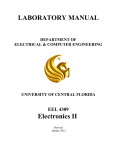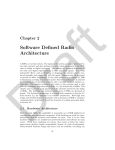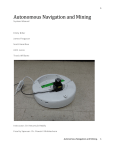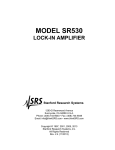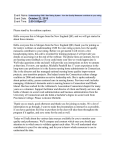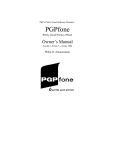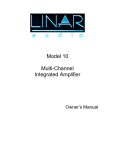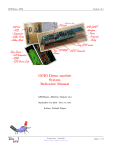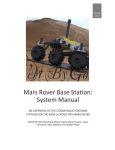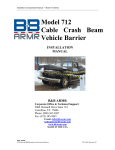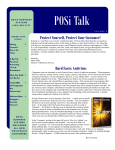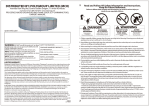Download Assignment 7
Transcript
System Manual Through The Earth Communication Project Authors: Dakota Kirby, Mark Ladesic Spring 2013 Revision 1.0 Abstract (Author: Dakota Kirby and Mark Ladesic) The intent of this project is to demonstrate a proof on concept of through the earth communication. It was proposed that low frequency signals (<10kHz) would provide deeper penetration of the earth surface. Thus, the goal of this project was to create a system that could receive low frequency signals in order to be able to be processed by a communication system. There was much debate on how to approach designing such a system. The team finally agreed upon building a relatively small antenna with a hardware preamp so that the signals could be sent to a computer for further processing. Both tasks were completed within the semester and the group determined some things for future groups to work on. We have yet to test the system through the earth, but we have has receiving known signals at these low frequencies that are visible in the Engineering Sciences Building. 2 Table of Contents 1 Introduction ............................................................................................................................................... 7 2 Design Achievements ................................................................................................................................. 8 3 Hardware Design ........................................................................................................................................ 9 3.1 Preamp Design .................................................................................................................................... 9 3.1.1 General Preamp Design ............................................................................................................... 9 3.1.2 Schematic Design ....................................................................................................................... 13 3.1.3 Bill of Materials .......................................................................................................................... 15 3.1.4 Part Analysis ............................................................................................................................... 19 3.1.5 Schematic Re-design .................................................................................................................. 23 3.1.6 Breadboard Prototype ............................................................................................................... 25 3.1.7 PCB Design and Construction..................................................................................................... 26 3.1.8 Box Layout .................................................................................................................................. 30 3.2 Antenna design ................................................................................................................................. 31 4 Software Design ....................................................................................................................................... 37 5 Test Results .............................................................................................................................................. 38 5.1 Preamp .............................................................................................................................................. 38 5.1.1 Initial Testing .............................................................................................................................. 38 5.1.2 Performance Testing .................................................................................................................. 40 5.2 Antenna ............................................................................................................................................. 43 5.2.1 Initial Testing .............................................................................................................................. 43 5.2.2 Performance Testing .................................................................................................................. 43 5.3 System Tests...................................................................................................................................... 45 6 Safety Precautions ................................................................................................................................... 47 7 Reflections................................................................................................................................................ 48 8 Appendix 1– User Manual ........................................................................................................................ 49 9 Appendix 2 – Maintenance Manual ......................................................................................................... 51 10 Appendix 3 – Original Design Proposal .................................................................................................. 52 11 Appendix 4 – Summary of Changes ....................................................................................................... 98 3 Table of Figures Figure 1 Signal Flow ...................................................................................................................................... 9 Figure 2 Gain Equation .................................................................................................................................. 9 Figure 3 Notch Filter Equation .................................................................................................................... 10 Figure 4 Step 1 ............................................................................................................................................ 11 Figure 5 Step 2 ............................................................................................................................................ 11 Figure 6 Step 3 ............................................................................................................................................ 11 Figure 7 Step 4 ............................................................................................................................................ 11 Figure 8 Step 5 ............................................................................................................................................ 11 Figure 9 Original Schematic ........................................................................................................................ 13 Figure 10 Original Frequency Response...................................................................................................... 13 Figure 11 50 Hz Preamp .............................................................................................................................. 14 Figure 12 Modified Schematic .................................................................................................................... 23 Figure 13 Modified Frequency Response ................................................................................................... 23 Figure 14 Original 60 Hz Notch ................................................................................................................... 24 Figure 15 Modified 60 Hz Notch ................................................................................................................. 24 Figure 16 Breadboard Prototype ................................................................................................................ 25 Figure 17 PCB Schematic............................................................................................................................. 26 Figure 18 PCB Layout Top ........................................................................................................................... 27 Figure 19 PCB Layout Bottom ..................................................................................................................... 27 Figure 20 3D PCB Layout Top ...................................................................................................................... 28 Figure 21 3D PCB Layout Front ................................................................................................................... 28 Figure 22 3D PCB Layout Side ..................................................................................................................... 28 Figure 23 PCB Top ....................................................................................................................................... 28 Figure 24 PCB Side ...................................................................................................................................... 29 Figure 25 PCB Soldered Top ........................................................................................................................ 29 Figure 26 PCB Soldered Bottom .................................................................................................................. 29 Figure 27 Box Layout ................................................................................................................................... 30 Figure 28 Final Antenna Design .................................................................................................................. 31 Figure 29 Bare Structure ............................................................................................................................. 32 Figure 30 Hinge Point .................................................................................................................................. 33 Figure 31 Collapsed Antenna ...................................................................................................................... 34 Figure 32 Side Profile .................................................................................................................................. 35 Figure 33 Completed Antenna .................................................................................................................... 36 Figure 34 PCB Correction Top ..................................................................................................................... 38 Figure 35 PCB Correction Bottom ............................................................................................................... 38 Figure 36 PCB Correction Close-Up............................................................................................................. 39 Figure 37 Full Test Setup ............................................................................................................................. 40 Figure 38 Test Setup 1................................................................................................................................. 40 Figure 39 Test Setup 2................................................................................................................................. 40 Figure 40 Preamp Frequency Response...................................................................................................... 41 4 Figure 41 Preamp No Power ....................................................................................................................... 42 Figure 42 Preamp Shorted Input ................................................................................................................. 42 Figure 43 Antenna up to 100 Hz ................................................................................................................. 44 Figure 44 Antenna up to 250 Hz ................................................................................................................. 44 Figure 45 System No Power ........................................................................................................................ 45 Figure 46 System Powered ......................................................................................................................... 45 Figure 47 Collapsed Antenna ...................................................................................................................... 49 Figure 48 Full Antenna ................................................................................................................................ 49 Figure 49: Mining Fatalities......................................................................................................................... 57 Figure 50: Low Frequency Radio Design ..................................................................................................... 61 Figure 51 Objective Tree ............................................................................................................................. 63 Figure 52 Top Level Architecture ................................................................................................................ 69 Figure 53 Second Level Architecture .......................................................................................................... 70 Figure 54 Amplification and Filtering Architecture..................................................................................... 70 Figure 55 Use Case ...................................................................................................................................... 71 Figure 56 User Interface Specification ........................................................................................................ 72 Figure 57 User Interface.............................................................................................................................. 73 Figure 58 Dataflow Diagram ....................................................................................................................... 74 Figure 59 Circuit Diagram............................................................................................................................ 75 Figure 60 WIKI Page .................................................................................................................................... 85 Figure 61: Mining Fatalities......................................................................................................................... 88 Figure 62: Low Frequency Radio Design ..................................................................................................... 92 5 Table of Tables Table 1 Capacitor BOM ............................................................................................................................... 15 Table 2 Potentiometers BOM ..................................................................................................................... 15 Table 3 OpAmp BOM .................................................................................................................................. 15 Table 4 Resistors BOM ................................................................................................................................ 15 Table 5 Resistors Full BOM ......................................................................................................................... 16 Table 6 Capacitors Full BOM ....................................................................................................................... 17 Table 7 Potentiometers Full BOM............................................................................................................... 18 Table 8 OpAmp Full BOM ............................................................................................................................ 18 Table 9 Resistors Tolerances ....................................................................................................................... 19 Table 10 Resistors Summary ....................................................................................................................... 20 Table 11 Capacitors Tolerances .................................................................................................................. 20 Table 12 Capacitors Summary .................................................................................................................... 20 Table 13 Full Resistors Tolerances .............................................................................................................. 21 Table 14 Full Capacitors Tolerances............................................................................................................ 22 Table 15 Antenna Measurements............................................................................................................... 43 Table 16 Engineering Requirements ........................................................................................................... 66 Table 17 Marketing Requirements ............................................................................................................. 66 Table 18 Mapping of Requirements ........................................................................................................... 67 Table 19 EM Trade-Off Chart ...................................................................................................................... 67 Table 20 EE Trade-Off Chart........................................................................................................................ 68 Table 21 Component Tests ......................................................................................................................... 76 Table 22 Failure Mode ................................................................................................................................ 76 Table 23 Integration Test Cases for Aboveground and Underground Systems .......................................... 77 Table 24 Work Breakdown.......................................................................................................................... 79 Table 25 Gantt Chart ................................................................................................................................... 81 Table 26 Milestones .................................................................................................................................... 82 6 1 Introduction (Author: Mark Ladesic) This document serves as documentation of the tasks completed for our senior design project, Through The Earth (TTE) Communication. The goal of this project was to design and implement a system that was able to receive a very low frequency signal which would then be amplified and filtered for communication. Communication through the earth is essential in underground mining; a communication link for emergencies is vital when trapped hundreds of feet under the surface. Communication through the earth is not a simple task due to many factors regarding low frequency waves. The purpose of this project is to make use of relatively-new technology to create a product whose primary purpose is to provide an emergency communication link for miners to aboveground crews in the event of a disaster. This communication will be done at very low frequencies for the reason that high frequencies are unable to penetrate deep into the earth’s surface. The use of these low frequencies gives rise to many problems such as antenna size, data transfer and data analysis. It has been found that these problems can be overcome and a new cutting edge receiver that is both reliable and efficient can be developed. It was found that some of these problems could be minimized by a combination of many different aspects. This communication link was found to be much more reliable and efficient when the process was completed by integrating both hardware and software techniques to. These techniques not only improved our receiver but it also helped reduce the physical size of the components that are to be used. The hardware consists of a low frequency antenna and a pre-amp that will amplify the signal received by the antenna. The software will be responsible for both the filtering and the cleaning up of the received signal. If these processes are integrated correctly a device that is lightweight, compact and rugged enough to withstand the harsh environment of a coal mine as well as a reliable communication link to the surface will result. 7 2 Design Achievements (Author: Dakota Kirby) The problem we were challenged with was building a communication system that is capable of communication deep into the Earth. The system should be able to communicate two ways from beneath the surface of the Earth to someone on top of the surface. The system must also be small and portable such that it could be carried on someone's person deep into a mine without adding too much bulk. This problem we can break into two parts, hardware and software. Specifically the antenna system and digital signal processing. We decided to turn our attention towards hardware. For the radio system to be successful, it must contain an antenna for receiving signals and some sort of amplifier so that the signal strength may be increased enough to be seen in software. The antenna design was crucial to the performance of the system, without the proper antenna the system will have trouble being able to receive our low frequencies. The group was able to design a relatively small antenna compared to the size of antenna that is recommended for these frequencies. The next main hardware challenge comes with the amplifier or more notable called the preamp among radio circles. Many of the challenges that were faced with the pre-amp is how many stages of gain would be needed, how much filtering should be done, how much should you actually build in hardware and what should be placed into software and what does a pc sound card need in order to receive a signal. We determined that any signal over about 1mV would be sufficient to be seen in the computer. Two gain stages were set to be created and three filters were to be used in order to achieve the low frequency. The group was able to build such a device during the course of this project. In software there were many parts to be worked on but this group was not able to achieve any of the software goals that they had set out to try and accomplish. Designing a low frequency radio communication system has a multitude of challenges that are associated with outside of the obvious system design challenges and the group experienced most of them. The lack of research material and resources for a system at this frequency definitely impeded the group’s progress greatly, but the team was still able to accomplish all hardware goals that the team wanted to accomplish. The group though was not able to accomplish any of the software goals, but these goals were already less important for this group to work on over the course of the project. Overall the group did well accomplishing most of their original goals. 8 3 Hardware Design (Author: Dakota Kirby and Mark Ladesic) From the research that the team has done we know that the expected signal level of the Schuman resonance signals (a signal that resonates between the core of the Earth and ionosphere) is around 0.5ρT (pico Tesla). From this we were able to design the entire system so that we can receive this signal. 3.1 Preamp Design (Author: Dakota Kirby) This section describes the entire process of designing the preamp from conception of the design and redesign to physical layout of the circuit on a PCB. 3.1.1 General Preamp Design (Author: Dakota Kirby) The preamp was designed with a simple modular design so that it was easy to design, assemble, and test. Below is a block diagram of the signal flow. Gain Stage 1 60 Hz Notch Filter 180 Hz Notch Filter Gain Stage 2 Low Pass Filter Figure 1 Signal Flow Each stage of the preamp was designed individually by hand with just a few calculations with the exceptions of the final stage of the design the low pass filter which will be discussed shortly. There are two main formulas needed in order to design and kind of gain stage of notch filter. First is the gain portion of the circuit. The image and equation show a representation of how to calculate this. Figure 2 Gain Equation From this we were able to determine that the gain of Gain Stage 1 should be around 50, and that for Gain Stage 2 it should be around 22. This gives us a total system gain of about 1,100. Based on the face that our expected signal level is around 1 µV this brings our signal up to approximately 1.1 mV, which is enough strength to be picked up by any standard sound card on a pc. The next thing to be designed was the notch filters below is an image and formula of how they can be designed. Figure 3 Notch Filter Equation We knew that there would be a problem with the 60 Hz so a notch filter was designed to handle this specific frequency taking into account, for R and C, what values were common and would be easy for the group to obtain. It was also determined that 120 Hz and 180 Hz may be a problem also. The group then determined that odd harmonics of the original 60 Hz were much stronger than the even ones so only 180 Hz was also notched out using the above equations and design. With now the notch filters designed and the gain stages. The only thing left was to design the low pass filter. The ultimate goal of this project is to receive all signals all the way up to 22 KHz, but the group determined to stay below 60 Hz to help with additional filtering of the unwanted signals. Due to the complexity of designing a multi-stage active low pass filter software was used to design this filter. The software was chosen was the software TI makes called FilterPro Desktop. Below is screen shots of the program stepping through its design process, this was not the process that designed the filter for this preamp though. 10 Figure 4 Step 1 Figure 6 Step 3 Figure 5 Step 2 Figure 7 Step 4 Figure 8 Step 5 This program was used to create a low pass filter the resulted in the 60 Hz hum being at least at the 3 dB roll off point and it was achieved at an even lower point. The filter also because of the design constraints of the program has a gain of approximately 3 moving the gain up to almost 3,500 increasing our signal level even more. 12 3.1.2 Schematic Design (Author: Dakota Kirby) Now with the preamp fully designed the team was able to use LTSpice to simulate the design and determine the output from the system, mainly the frequency response of the system. Below is the schematic of the system. This schematic uses the same op-amp throughout the design for simplicity when designing the original system. Figure 9 Original Schematic From the schematic it can be seen that the system operates off of 6V and each stage of the system can be clearly seen. The frequency response of the system is below. Figure 10 Original Frequency Response 13 The output clearly shows the notch at both 60 Hz and 180 Hz. From this we can determine the system gain overall we know that the input into the circuit is 1 µV which has a dB value of -120. From the graph we can see that the system is at approximately -50 dB which is a gain of 70 dB. 70 dB converted back into gain is a gain of 3162. Which is very near the original value we had expected. NOTE: From here out in this document the part numbers will all match up with the values across all schematics and parts lists. Now with a design the parts had to be sourced. From the design it can be seen that 9 op-amps are needed. Due to the nature of our design we needed the first stage to have very low noise in order not to distort the incoming signal. For this we chose the LT1007, there we many considerations for this opamp. Linear Technology is currently the leader in the groups opinion when dealing with low noise opamps which is why the group when with the LT1007. For the remaining stages of op-amps they were pulled from a design that had been previously done by a group from Italy. Below is their design. Figure 11 50 Hz Preamp This design was very complex, but was very useful in determining some of the standard capacitors that could easily be found. Some things were left the same from this design primarily the op-amps that were used. It can also be seen that this group had also chosen the LT1007 which even more verified our original design. 14 3.1.3 Bill of Materials (Author: Dakota Kirby) Once all the op-amps were decided we created out parts list so that we could collect all the parts needed for our circuit. Below is all our parts lists for this preamp. Capacitors Value (see Full BOM for Units) 4.7 0.1 0.22 0.001 330 Quantity 8 6 6 2 1 Resistors Table 1 Capacitor BOM Name Quantity LT1007 1 OP07 4 OP27 1 TL072 2 TL081 1 Value (Kohms) Quantity 100 3 6.8 6 3.9 2 82 1 39 3 180 2 12 2 2.2 1 270 1 10 4 560 2 18 1 47 1 5 2 Table 3 OpAmp BOM Table 4 Resistors BOM Potentiometers (3296) Value (Kohms) Quantity 100 200 500 2 1 1 Table 2 Potentiometers BOM OpAmps Finally we had our parts list and were able to get all the parts on our list and begin construction of the first prototype of the preamp. First we had to address the issue of every component with the exception of the op-amps and the potentiometers has a tolerance level that we need to account for. Now that all the parts were in our possession we needed to determine the actual values of each component used in the circuit. For this we created a full bill of materials the specifically lays out each part number so we could analyze each part individually. 15 Resistors Part Number R01 R02 R03 R04 R05 R06 R07 R08 R09 R11 R12 R13 R14 R15 R16 R17 R18 R19 R20 R21 R22 R23 R24 R25 R26 R27 R29 R30 R31 R32 R33 Theortical Value (Kohms) 100 6.8 3.9 100 82 39 6.8 180 12 10 2.2 180 10 100 270 6.8 560 12 39 6.8 5 560 10 10 18 5 6.8 39 6.8 47 3.9 Table 5 Resistors Full BOM 16 Capacitors Part Number C01 (uF) C02 (uF) C03 (uF) C04 (nF) C05 (uF) C06 (uF) C07 (nF) C08 (uF) C09 (nF) C10 (nF) C11 (nF) C12 (uF) C13 (uF) C14 (nF) C15 (uF) C16 (nF) C17 (uF) C18 (nF) C19 (pF) C20 (uF) C21 (uF) C22 (uF) C23 (uF) Theortical Value 0.22 0.001 0.1 4.7 0.22 0.1 4.7 0.001 4.7 4.7 4.7 0.22 0.1 4.7 0.22 4.7 0.1 4.7 330 0.22 0.1 0.22 0.1 Table 6 Capacitors Full BOM 17 Potentiometers (3296) Part Number RV1 RV2 RV3 RV4 Theortical Value (Kohms) 100 100 200 500 Table 7 Potentiometers Full BOM OpAmps Part Number U01 U02 U03 U04 U05 U06 U07 U08 U09 Part Name LT1007 TL072 OP07 OP07 TL072 OP07 OP07 OP27 TL081 Table 8 OpAmp Full BOM 18 3.1.4 Part Analysis (Author: Dakota Kirby) For this we decided in order to get a better design schematic of what we would actually expect to see from out preamp we decided to measure each component and get its actual value. With these value we will be able to redesign the schematic and get a better prediction of what to expect from out circuit. Resistors Part Number R01 R02 R03 R04 R05 R06 R07 R08 R09 R11 R12 R13 R14 R15 R16 R17 R18 R19 R20 R21 R22 R23 R24 R25 R26 R27 R29 R30 R31 R32 R33 Theortical Value Actual Value Precent Difference 100 99.7 0.30% 6.8 6.73 1.03% 3.9 3.8 2.56% 100 99.2 0.80% 82 81.4 0.73% 39 38.7 0.77% 6.8 6.73 1.03% 180 166.4 7.56% 12 11.83 1.42% 10 9.92 0.80% 2.2 2.12 3.64% 180 166.4 7.56% 10 9.92 0.80% 100 99.5 0.50% 270 266 1.48% 6.8 6.73 1.03% 560 552 1.43% 12 11.86 1.17% 39 38.6 1.03% 6.8 6.72 1.18% 5 4.64 7.20% 560 550 1.79% 10 9.91 0.90% 10 9.9 1.00% 18 17.75 1.39% 5 4.63 7.40% 6.8 6.72 1.18% 39 38.7 0.77% 6.8 6.73 1.03% 47 46.8 0.43% 3.9 3.84 1.54% Table 9 Resistors Tolerances 19 Max: Min: Average: Deviation: 7.56% 0.30% 1.98% 2.22% Table 10 Resistors Summary Capacitors Part Number C01 C02 C03 C04 C05 C06 C07 C08 C09 C10 C11 C12 C13 C14 C15 C16 C17 C18 C19 C20 C21 C22 C23 Theoretical Value Actual Value Percent Difference 0.22 0.206 6.36% 0.001 0.001038 3.80% 0.1 0.092 8.00% 4.7 4.72 0.43% 0.22 0.207 5.91% 0.1 0.092 8.00% 4.7 4.71 0.21% 0.001 0.000957 4.30% 4.7 4.71 0.21% 4.7 4.69 0.21% 4.7 4.71 0.21% 0.22 0.208 5.45% 0.1 0.092 8.00% 4.7 4.72 0.43% 0.22 0.206 6.36% 4.7 4.7 0.00% 0.1 0.092 8.00% 4.7 4.69 0.21% 330 336 1.82% 0.22 0.206 6.36% 0.1 0.092 8.00% 0.22 0.207 5.91% 0.1 0.092 8.00% Table 11 Capacitors Tolerances Max: Min: Average: Deviation: 8.00% 0.00% 4.18% 3.30% Table 12 Capacitors Summary 20 From the above tables we can see how the resistors and capacitors vary in their values and are not exactly what they say they are. From this we were able to determine another set of tables that show us how far we are off from our original design values, to help us better predict the performance of our circuit. Resistors Percent Difference Total Difference Number Design Value Value Actual Value (Value vs. Actual) (Design vs. Actual) R1 100 100 99.7 0.30% 0.30% R2 3.9 3.9 3.8 2.60% 2.60% R3 100 100 99.5 0.50% 0.50% R4 180 180 178.8 0.67% 0.67% R5 565 565 554.64 1.85% 1.85% R6 565 565 554.64 1.85% 1.85% 282.5 R7 282 276.86 1.84% 2.02% R8 100 100 99.6 0.40% 0.40% R9 190 190 189.42 0.31% 0.31% R10 190 190 189.42 0.31% 0.31% 95 R11 94 93.23 0.82% 1.88% R12 10 10 9.91 0.90% 0.90% R13 220 220 217 1.37% 1.37% R14 10 10 9.91 0.90% 0.90% R15 39 39 38.7 0.77% 0.77% R16 2.2 2.2 2.17 1.37% 1.37% R17 6.5 6.8 6.73 1.03% 3.48% R18 6.5 6.8 6.73 1.03% 3.48% R19 39 39 38.6 1.03% 1.03% R20 18 18 17.75 1.40% 1.40% R21 6.5 6.8 6.72 1.18% 3.33% R22 6.5 6.8 6.72 1.18% 3.33% R23 39 39 38.7 0.77% 0.77% R24 51 50.9 50.64 0.51% 0.71% R25 6.5 6.8 6.73 1.03% 3.48% R26 6.5 6.8 6.73 1.03% 3.48% Max: Min: Average: Deviation: 0.30% 2.60% 1.04% 0.25% Table 13 Full Resistors Tolerances 21 0.30% 3.48% 1.63% 1.24% Capacitors Number C1 (micro) C2 (micro) C3 (nano) C4 (nano) C5 (nano) C6 (nano) C7 (nano) C8 (nano) C9 (pico) C10 (micro) C11 (micro) C12 (micro) C13 (micro) C14 (micro) C15 (micro) Percent Difference Total Difference Design Value Value Actual Value (Value vs. Actual) (Design vs. Actual) 0.001 0.001 0.001038 3.73% 3.73% 0.001 0.001 0.000957 4.39% 4.39% 4.7 4.7 4.71 0.21% 0.21% 4.7 4.7 4.72 0.42% 0.42% 9.4 9.4 9.39 0.11% 0.11% 4.7 4.7 4.72 0.42% 0.42% 4.7 4.7 4.71 0.21% 0.21% 9.4 9.4 9.4 0.00% 0.00% 330 330 336 1.80% 1.80% 0.33 0.32 0.298 7.12% 10.19% 0.33 0.32 0.299 6.79% 9.86% 0.33 0.32 0.3 6.45% 9.52% 0.33 0.32 0.298 7.12% 10.19% 0.33 0.32 0.298 7.12% 10.19% 0.33 0.32 0.299 6.79% 9.86% Max: Min: Average: Deviation: Table 14 Full Capacitors Tolerances 22 0.00% 7.12% 3.51% 3.14% 0.00% 10.19% 4.74% 4.60% 3.1.5 Schematic Re-design (Author: Dakota Kirby) Now that we know all the values for each part of the circuit we can re-evaluate the circuit schematic and determine what differences we should expect in our final product. Figure 12 Modified Schematic This schematic produces the following output. Figure 13 Modified Frequency Response 23 At first glance when you look at this it is identical to the original circuit, but actually there is 2 dB more gain resulting in a gain of almost 4000 and the notch filters aren’t as exact like they were originally. Below you can see this more closely. Figure 14 Original 60 Hz Notch Figure 15 Modified 60 Hz Notch From these two graphs we can see that there is a difference in the notch depth and the new updated schematic drifts slightly away from 60 Hz over to 61 Hz, but overall this shouldn’t affect the system too much. 24 3.1.6 Breadboard Prototype (Author: Dakota Kirby) The circuit was first assembled on a bread board that was used so that it could be easily tested with the lab equipment that was available to us. Below is a picture of the fully assembled bread board prototype. Figure 16 Breadboard Prototype It was tested with an oscilloscope and function generator and was determined that the circuit was working, but due to the issues with breadboards, including noise generated by the way the board is wired and coupling capacitance between spaces in the board, another form of the circuit was needed in order to determine the actual frequency response of the system. 25 3.1.7 PCB Design and Construction (Author: Dakota Kirby) It was determined that the best option would be to pursue designing and building a PCB. KiCad was used to design the PCB. The difference schematics and board views can be seen below. Figure 17 PCB Schematic 26 Figure 18 PCB Layout Top Figure 19 PCB Layout Bottom 27 Figure 20 3D PCB Layout Top Figure 21 3D PCB Layout Front Figure 22 3D PCB Layout Side The board was verified with the design rules checker that is built into KiCad and then was sent out to be manufactured. Upon receiving the boards (because of the manufactures cost structure we ended up with 8 boards all joined together). We had to get them cut down to the proper size. Figure 23 PCB Top 28 Figure 24 PCB Side Now that the boards we could proceed with soldering the boards. The team practiced on some other boards before proceeding to these boards. They results can be seen below. Figure 25 PCB Soldered Top Figure 26 PCB Soldered Bottom Now that the board was fully assembled and soldered it was ready to be tested and characterized. 29 3.1.8 Box Layout (Author: Dakota Kirby) At the time of this writing the box has not been constructed, but one has been created and below is a diagram of how the box will be set up for use. +9V AA Battery Pack (6 Cell) -9V AA Battery Pack (6 Cell) Preamp BNC Connector Input Power Switch Figure 27 Box Layout 30 BNC Connector Output 3.2 Antenna design (Author: Mark Ladesic) Although our design may look relatively simple there was great thought and time invested into this. The Antenna design became very time consuming due to the small amount of information available on low frequency antennas and the complexity of the mathematics that arose when attempting to theoretically build the antenna. There are many factors that were taken into consideration when building an antenna for low frequency communication. The radiation pattern, efficiency and the physical size of the antenna were three of the most important factors that needed the most consideration. The physical size is an obvious concern because we will need this antenna to be located within a mine hundreds of feet below the crust where space is at a minimum. The radiation pattern is also a major concern because if your pattern is incorrect you will be unable to pick up the signal sent from the surface of the earth. Finally the efficiency is a major concern because low frequency signals have very low power and if our antenna was not efficient enough it could not work properly. After consulting with many different websites and antenna handbooks we were able to find that a cube shape would be the ideal antenna design for our antenna. The next step was to find the number of windings needed, weigh and physical size needed to communicate at these frequency levels. There were many different tradeoffs that needed to be taken into consideration but after much many design ideas were compared the design was found to be the best. Figure 28 Final Antenna Design 31 Figure 29 Bare Structure 32 Figure 30 Hinge Point We decided to implement a hinge type device into our structure giving us the option of either collapsing the antenna or leaving it in its rigid shape. This was done so the antenna could be packed up for much easier transportation. Our antenna is able to be operated both collapsed or in its rigid form but communication is the best when expanded into its shape due to the larger area it is able to occupy. 33 Figure 31 Collapsed Antenna 34 Figure 32 Side Profile 35 Figure 33 Completed Antenna 36 4 Software Design (Author: Dakota Kirby) There was originally some plans to work on some software for this project, but the group that worked on this project found that the software should be left for another group to tackle. The team only focused on hardware after determining that a software implementation would be too difficult to tackle also with all the hardware that was being built. 37 5 Test Results (Author: Dakota Kirby and Mark Ladesic) This section describes that testing that was done to the system to ensure that it was working as expected and there were no safety hazards to be concerned with for the system. 5.1 Preamp (Author: Dakota Kirby) In this section the testing of the preamp was done. The preamp was tested alone in this section and was not connected to any antenna just a function generator that acted as an antenna. This helped avoid the 60 Hz hum so that the preamp could be better compared to the simulations that were performed. 5.1.1 Initial Testing (Author: Dakota Kirby) Upon completion of soldering of the PCB it was time to begin testing the board to confirm all connections were appropriately made with the board. Once initial testing began to confirm the board was correctly designed and soldered and error was found. Looking at the schematic above in section 3.1.7 it can be seen that on part U8, the second gain stage that an incorrect connection was made. The power connections were crossed in the layout and design of the PCB. After close consultation with Dr. Nutter it was determined that the connection could be fixed by cutting the copper traces that were bad and then soldering wire onto the board to make the correct connections. Figure 34 PCB Correction Top Figure 35 PCB Correction Bottom It can be seen in the top image were the board was “scratched” to cut the copper traces that were causing the power cross over. Below is a close up of the copper traces cut. 38 Figure 36 PCB Correction Close-Up One those corrections were made the circuit was hooked back up for testing and the group was able to confirm that the board was not operational and was ready for more in depth testing. 39 5.1.2 Performance Testing (Author: Dakota Kirby) In order to fully characterize the preamp alone it was decided to sweep frequencies through the preamp and measure their outputs in order to determine the frequency response of the circuit. The setup that was used is shown below. Figure 37 Full Test Setup Figure 38 Test Setup 1 Figure 39 Test Setup 2 The resistors on the board were used to create different signal levels that could be used in the preamp. The sweep was done in a particular manner. Frequencies beginning with 1 Hz all the way up to 100 Hz were swept through at 5 Hz increments and from 100 Hz to 200 Hz in 25 Hz increments and then from 200 Hz to 1000 Hz in 100 Hz increments. Below is the resulting graph from this frequency sweep. 40 Preamp Frequency Response 70 60 Gain (dB) 50 40 1.5 uV 30 400 uV 20 10 0 1 10 100 1000 Frequency (Hz) Figure 40 Preamp Frequency Response From this graph it is clear that the circuit performs like we had originally expected. There are still some issues with the hardware that we didn’t see in the software though. From the graph you can see that frequencies less than 10 Hz weren’t quite as high as was expected and overall the signal level was less than expected. We had expected a gain of almost 4000, but we were only able to achieve a max gain of 1000 with the same system parameters as the simulations. The 60 Hz notch performed well and the 180 Hz notch placed the signal well below the noise floor. The test were run in “ideal” conditions in which the 60 Hz hum was not seen in the circuit. When connected to an antenna the response will be the same but the 60 Hz will be much stronger than was in this testing. Another figure to measure was the noise that is generated by the circuit itself and what signals it can pick up under its own power. Below is a snapshot of the frequency display when the op-amp is turned off. 41 Figure 41 Preamp No Power With this we can see where the noise floor is at and with the input shorted we can take another picture and see what the noise performance of the circuit looks like. Figure 42 Preamp Shorted Input From this we can see that there is considerable noise under 30 Hz, this is speculated to be due to the 60 Hz signal that is also present in the image. Simply shorting the input with a wire has the capability to act as an antenna. Which is the reason for the signal at 60 Hz, but overall we can see that the circuit does work and there is a great deal of noise generated by circuit. 42 5.2 Antenna (Author: Mark Ladesic) In this section the testing of the antenna was done. The antenna was tested alone in this section and was not connected to any preamp. 5.2.1 Initial Testing (Author: Mark Ladesic) Our initial tests were relatively trivial, our main objective in this round of testing was to characterize the antenna and insure that our antenna was in fact working correctly. To maximize power we needed to match its impedance, to do this we connected an LCR meter to our antenna which collects impedance as a function of frequency. We then connected the antenna to a multi meter to continue collecting the remainder of the data. 5.2.2 Performance Testing (Author: Mark Ladesic) After initial testing was completed we needed to characterize the antenna over the range of frequencies that will be used with our device to ensure our antenna is operating correctly. This was done by using a variable frequency LCR meter and an oscilloscope , the results were as followed: Table 15 Antenna Measurements 43 Figure 43 Antenna up to 100 Hz Figure 44 Antenna up to 250 Hz 44 5.3 System Tests (Author: Dakota Kirby and Mark Ladesic) To test the system as a whole is a difficult challenge. This receiver system was designed to work with very low frequencies. There are not many signals that can be seen at these low frequencies besides the 60 Hz hum noise that can be seen no matter where you are. There are a few natural signals that can be seen by low frequency antennas, but the system should be far away from the 60 Hz in order to see them clearly. Due to limitations with time and testing environments that system was inside the Engineering Sciences Building at WVU for the purposes of this paper. Below is a picture of the FFT of the system output when the preamp is not powered by anything. Figure 45 System No Power This image gives a base reference so it can be seen what the output of the system is. The 60 Hz is clear here and is much stronger than all other signals. The image below shows an output of the system. Figure 46 System Powered 45 The 60 Hz is a clear signal, so we can clearly see that the system is receiving a signal and is able to amplify/attenuate any incoming signals. From this though that the other signals have come to be the same power level as the 60 Hz showing that the preamp attenuates the 60 Hz and amplifies the other signals. There are some other signals that are visible in the FFT. We can once again see the increased noise floor, from the preamp and we can see other signals at approximately 20 Hz and 30 Hz. These are believed to be the natural signals from the Earth, but could not be confirmed at the time of this writing. We can confirm that the system is working, but it needs deeper and more through testing with a proper transmitter to determine the quality of the system as a whole. 46 6 Safety Precautions (Author: Dakota Kirby) The radio is designed to be a low power system. Thus, there are not many safety issues, but there are still some that must be handled. Standard electrical safety protocols should be followed when working with the system. The user should always wear a static discharge strap, handle hardware delicately, and be wary of any unprotected wires. One should know the specifications and technological limits of the hardware. Specifically for this project the preamp can only handle up to 22 volts any exceeding that will saturate the op-amps and could eventually cause them to fail. The preamp was designed though for 6 volts so it is recommended to stick to that voltage. Do not touch any part of the preamp while voltage has been given to any part of the circuit. The antenna detects the magnetic field not the electrostatic field thus RF burns should be less of a concern, but since the antenna is very wideband it is possible that stronger RF signals could be detected. It is recommended to never touch the wires unless absolutely necessary to prevent any injuries, even if the wire is insulated. The antenna is also built on a wood frame which is susceptible to damage if not handled correctly. The wire itself puts a lot of pressure on the wood, so it is not recommended that the antenna be moved much without the proper handling and more than one person. Because this is a low voltage system though, there should not be any foreseeable cause of serious injury. There can be problems if the hardware is pushed beyond its design specifications. Overpowering a system can lead to hardware failure and possibly a fire, but this is an extreme case and is not likely to happen. 47 7 Reflections (Author: Dakota Kirby and Mark Ladesic) Going into this project we had expected it to be much easier than it turned out to be. This was not a bad thing; we were able to take many of the concepts that we learned from this project and apply it to our classes and also hopefully a career. This project made us realize that we truly enjoy communications and opened our eyes to many career opportunities that we were unaware of. We believe that with the progress we made on this project it will be very easy for the next group to finally complete the entire communication system. We also believe that the work we put into this and the amount of time we put into the documentation will make it very easy for someone with not much of a technical background to understand what was accomplished. 48 8 Appendix 1– User Manual (Author: Dakota Kirby) To use the system in its current state the user must have a couple things in order to get started. A computer is needed to visualize the signals and some sort of digital oscilloscope that can be used by the computer to receive the signals from the system. To begin using the system make sure the antenna is in a location that is safe and the antenna set up fully by extending its legs from this state. Figure 47 Collapsed Antenna To its maximum state so that it doesn’t have a tendency to fall over and injury anyone nearby. Figure 48 Full Antenna 49 Now that the antenna is setup it may be plugged into the input of the preamp and then preamps output should be connected to the oscilloscope in order to see they signal. Make sure the preamp has charged batteries and ensure that the oscilloscope is running and the software is also running. With the system setup turn on the preamp by flipping the switch to the up position and enjoy your low frequency receiver. Upon completion of any radio activity be sure to unplug all cables and to turn the preamp off as to save the battery. The antenna may be collapsed in order for better transportation and storage. 50 9 Appendix 2 – Maintenance Manual (Author: Mark Ladesic) There is very little maintenance needed to keep the receiver portion of our system running and that was our exact goal. We knew this system was going to be in a very tough environment and any extra upkeep would be very taxing. The most important aspect of maintenance for our antenna is to ensure the wires on the antenna are intact and not dry rotting or ripping. We believe that with the wire used this problem will not arise for many years but with lives at risk this should always be checked. The most important aspect for the preamp is to ensure you always have batteries, because without power it is useless. We recommend you always keep spare batteries with you and always test the batteries before entering the mine. With this being enclosed in a box there shouldn’t be many problems with the board but periodical check-ups should always be completed because the components on the board are not guaranteed to last forever. 51 10 Appendix 3 – Original Design Proposal Design Proposal Through The Earth Communication Project Authors: Dakota Kirby, Mark Ladesic Fall 2013 Revision 1.0 52 Table of Contents 1 Introduction ............................................................................................................................................. 56 2 Extended Problem Statement .................................................................................................................. 57 2.1 Needs ................................................................................................................................................ 57 2.2 Ranking of Needs .............................................................................................................................. 58 2.3 Background ....................................................................................................................................... 59 2.3.1 Current Mine Communication Technology................................................................................ 59 2.3.2 Current Designs Low Frequency Systems .................................................................................. 60 2.4 Objectives.......................................................................................................................................... 62 2.5 Objective Tree ................................................................................................................................... 63 2.6 Stakeholders ..................................................................................................................................... 64 3 Requirements Specification ..................................................................................................................... 65 3.1 Functional Requirements .................................................................................................................. 65 3.1.1 Change Local Oscillator Frequency ............................................................................................ 65 3.1.2 Change Filter Frequency Specifications ..................................................................................... 65 3.1.3 Open Communication ................................................................................................................ 65 3.1.4 Close Communication ................................................................................................................ 65 3.2 Engineering Requirements ................................................................................................................ 66 3.3 Marketing Requirements .................................................................................................................. 66 3.4 Mapping of Marketing Requirements to Engineering Requirements .............................................. 67 3.5 Engineering and Marketing Requirements Trade-Off Chart ............................................................. 67 3.6 Engineering to Engineering Requirements Trade-Off Chart ............................................................. 68 3.7 Competitive Benchmarks .................................................................................................................. 68 3.8 Constraints and Standards ................................................................................................................ 68 4 System Design .......................................................................................................................................... 69 4.1 System Architecture .......................................................................................................................... 69 4.2 Use Case ............................................................................................................................................ 71 4.3 User Interface Specification .............................................................................................................. 72 4.4 Dataflow Diagram ............................................................................................................................. 74 4.5 Circuit and Logic Diagrams ................................................................................................................ 75 5 Test Plans ................................................................................................................................................. 76 53 5.1 Component Tests .............................................................................................................................. 76 5.2 Failure Mode Analysis ....................................................................................................................... 76 5.3 Integration Tests ............................................................................................................................... 77 5.4 Acceptance Tests .............................................................................................................................. 77 5.5 Description of Failure Modes ............................................................................................................ 78 5.6 System Recovery ............................................................................................................................... 78 6 Project Management Plan ....................................................................................................................... 79 6.1 Work Breakdown Structure .............................................................................................................. 79 6.2 Personnel Assignments ..................................................................................................................... 80 6.3 Gantt Chart........................................................................................................................................ 81 6.4 Milestones......................................................................................................................................... 82 7 References ............................................................................................................................................... 83 8 Appendix 1– Procurement List ................................................................................................................. 84 9 Appendix 2 – Project Website .................................................................................................................. 85 10 Appendix 3 – Individual Research Papers .............................................................................................. 86 10.1 Dakota Kirby .................................................................................................................................... 86 10.2 Mark Ladesic ................................................................................................................................... 97 54 Table of Figures Figure 1: Mining Fatalities........................................................................................................................... 57 Figure 2: Low Frequency Radio Design ....................................................................................................... 61 Figure 3 Objective Tree ............................................................................................................................... 63 Figure 4 Top Level Architecture .................................................................................................................. 69 Figure 5 Second Level Architecture ............................................................................................................ 70 Figure 6 Amplification and Filtering Architecture ....................................................................................... 70 Figure 7 Use Case ........................................................................................................................................ 71 Figure 8 User Interface Specification .......................................................................................................... 72 Figure 9 User Interface................................................................................................................................ 73 Figure 10 Dataflow Diagram ....................................................................................................................... 74 Figure 11 Circuit Diagram............................................................................................................................ 75 Figure 12 WIKI Page .................................................................................................................................... 85 Table of Tables Table 1 Engineering Requirements ............................................................................................................. 66 Table 2 Marketing Requirements ............................................................................................................... 66 Table 3 Mapping of Requirements ............................................................................................................. 67 Table 4 EM Trade-Off Chart ........................................................................................................................ 67 Table 5 EE Trade-Off Chart.......................................................................................................................... 68 Table 6 Component Tests ........................................................................................................................... 76 Table 7 Failure Mode .................................................................................................................................. 76 Table 8 Integration Test Cases for Aboveground and Underground Systems ............................................ 77 Table 9 Work Breakdown............................................................................................................................ 79 Table 10 Gantt Chart ................................................................................................................................... 81 Table 11 Milestones .................................................................................................................................... 82 55 1 Introduction (Author: Mark Ladesic) Communication through the earth is essential in underground mining; a communication link for emergencies is vital when trapped hundreds of feet under the surface. The goal of our project is to use very low frequencies to communicate primarily within deep coal mines. This Communication is done at very low frequencies for the reason that high frequencies are unable to penetrate deep into the earth’s surface. The use of these low frequencies gives rise to problems such as antenna size, data transfer and data analysis. The problems are believed to be minimized if this process is completed in both hardware and software. The hardware consists of a low frequency antenna and a pre-amp that will amplify the signal received by the antenna. The software will be responsible for both the filtering and the cleaning up of the received signal. If these processes are integrated correctly a device that is light-weight, compact and rugged enough to withstand the harsh environment of a coal mine as well as a reliable communication link to the surface will result. 56 2 Extended Problem Statement 2.1 Needs (Author: Dakota Kirby) The main need of this project is that communications in mines are poor and that new technology needs developed. That's where this project comes in. This project is attempting to increase the communications available to miners and mining companies for many reasons. The main reason though for the great need in an improvement in communication is, trapped miners after some sort of disaster in the mine. Now there are many needs within the main need. These all include the different safety standards that are imposed by MSHA, the fact that system has to be able to survive in an environment that is entirely underground, the it be low enough power that it can last at least for an entire mining shift and that it be small and simple enough for miners to use in tight, cramped spaces. This technology could also have other uses elsewhere in the world. The need to save the lives of the miners can be seen below in the graph (Regulation). From this graph we can see that the fatality rate of miners is decreasing but we can also that the number is not zero. This helps illustrate the fact that much work needs to be done here still and this project strives to help get that number even closer to zero. Figure 49: Mining Fatalities 57 2.2 Ranking of Needs (Author: Dakota Kirby) The most obvious need is that the system should be able to communicate thought the earth to the miners below the surface of the mine and then back up to the surface from the miners. The system needs to be able to communicate in order for it to be a working system at all. Also some other needs that must be met that aren't quite as obvious are listed and ranked below. From an engineering perspective, the product requirements/needs can be ranked as: 1. System must meet MSHA regulations A product that is going to be used as a means of helping increase miner safety should not be an item that prevents some sort of a hazard to the miner. 2. System must be rugged and durable This product is going to spend most of its time underground where a range of sources could damage the radio. This cannot be allowed to happen as this device for the miner’s safety and should work at all times and be able to handle all kinds of punishment that it may endure while underground. 3. Compact/lightweight Miners must carry enough gear into cramped spaces as it already is, so they don't need something that is big and bulky. Since this will be something else they will have to carry on them while in the cramped spaces of the mine it must be practical to transport and easy to carry and maneuver in the tight spaces. 4. Low Power There are many reasons that a low power system is needed. The first two reasons tie into needs one and two above. One for the system to be approved for use underground it will need to be low power, as high power could be dangerous to the miner. Second the system must be rugged and being a low power system means it can be smaller and easier to protect from the harsh environment. Lastly a low power system means longer life per battery charge, meaning a better success rate of reaching trapped miners. 58 2.3 Background (Author: Dakota Kirby) To better understand the problem, more needs to be learned about the current technologies employed in mines in the US and around the world and determine what parts are successful and what the drawbacks are. From this we will be able to draw some useful conclusions about what seems to be working and be able to develop a system that can implement the working parts and be able to handle long distance through the earth communications. This information will be split into two categories, current technology and current designs. In current technology I will discuss current low frequency radio systems that exist today and current technology that is used in mines. 2.3.1 Current Mine Communication Technology There are currently five major types of mine communication systems (Mine Safety and Health Administration). Each technology has its pros and cons. I will discuss each and how they are currently used in mining currently. Most technologies that are used have to be approved by the Mine Safety and Health Administration or MSHA, I will use MSHA throughout the rest of this paper to describe them. The first way and perhaps the most trivial is two-way radios. Two-way radios are handheld and very portable, more commonly known as "walkie-talkies". These systems can be modified for use in industry, but are mostly used by consumers. This radio systems is currently approved for use by MSHA, they are flexible in terms of frequency and can be easily used for voice communications. Some of the drawbacks of these radios is that the most generally apply to line of sight communication (where you can see the other person you want to talk to) and have extreme problems reaching miners inside the mine from outside, the rock in the mine eliminates most of the signal and is lost. (Mine Safety and Health Administration) The next important technology is the leaky feeder communication system. The leaky feeder communication works in combination with the above two-way radio system. How this system works is that by running a cable throughout the mine and allowing the radio signal to leak out into the mine people above ground can now communicate with the miners underground via the same two-way radios as above. This system provides the same benefits as the two-way radio system since no fundamental change has happened in the system. This does however suffer from even more drawbacks. All the same things apply from the two-way radios, but in any case that the leaky feeder cable is destroyed then the communication system would be disabled. (Mine Safety and Health Administration) The next significant technology that is used in mines are the mine page phones. These phones work very similar to a regular telephone as a telephone wire has to be run through the entire mine. With this system though a miner may be able to take a phone that is run off of a battery and then simply connect onto the wire and be able to listen and talk over the network. These 59 systems can also be very compact compared to typical telephones and are also MSHA approved. As with any system that requires a wire run anywhere the system is susceptible to damage. These systems are also dependent on batteries typically which they will need to be constantly checked and replaced. Also with the portable systems in the case of an emergency it may be difficult to find a wire to clip onto. (Mine Safety and Health Administration) The next technology is a new technology that is being introduced into mines. It's called the RFID tracking system. This system works by tracking a transmitter the mine wears and as he approaches a reader it will save his location and at what time that the miner was there. The system does well in the fact that in case of emergency in case the system does fail, it can still give the last known location of a miner. The major drawbacks of this system are that the readers are not MSHA approved, but they could be placed into protective cases. They are also very susceptible to damage and fire, and in most situations its 3000 feet between RFID stations and they can only reach about 200 feet ; this leaves a lot of mine area that there is no tracking taking place. (Mine Safety and Health Administration) The last major technology is the PED system. This system is a one-way radio system that acts as a "personal emergency device". The way this system works is quite more complex, but the simplest version is that, it is essentially a way for the people on the surface to send a simple text message to the miners underground. This system's benefits are that it can be run of the miner's lamp battery so that no extra batteries are needed and it is always with the miner when they are in the mine. This system has its drawbacks, the messages can take some time to be delivered which can be critical in an emergency and the antennas that are required for the transmissions are at high risk for damage. (Mine Safety and Health Administration) 2.3.2 Current Designs Low Frequency Systems With low frequency radio systems there are many things that must be considered. Typical systems contain an antenna, some sort of amplifier or pre-amp, that includes some sort of filtering and then typically some kind of software systems that is able to process that signals so that they can be listened to through a pair of headphones (Kramer). Most antennas are directly connected some sort of amplifier that is able to pull the signal out of the noise that surrounds it (ARRL). The figure below show how the system of an antenna and filter can be implemented. 60 Figure 50: Low Frequency Radio Design The first main thing to consider with a low frequency radio system is to think about the antenna that will be used to receive these signals. We know that the wavelength of a signal is proportional to the speed of light divided by the frequency of the signal (ARRL). We also know that the many antenna designs that are out there all ultimately depend on the wavelength of the signal (Payne). From this the antenna can be designed. There are many types of designs to consider. We also though need to determine an antenna frequency, so for the sake of this paper let’s assume a frequency of 60 Hz. So, for a 40 Hz antenna the wavelength of the signal comes out to be about 18 billion meters. This length is obviously not practical for a simple dipole antenna, which is equal to the length of the wavelength (ARRL). Antenna design is very crucial for a low frequency radio system; the most typical radio antenna that is used is the loop antenna. This type of antenna allows the system to make a more compact version of the lengthy antenna such that now it is a manageable size. There are two types of loop antennas; air loop and induction coils. An air loop is a very sensitive antenna that allows to very precisely tune the antenna to listen to the particular signals that you want here, but can be very bulky and hard to control due to its size. The induction coil antenna is much more practical in terms of its size but it’s much more expensive and can weigh a considerable amount due to the amount of copper in the antenna. (Bruna) The pre-amp is the remaining part of the system to be investigated. This part is typically less of a challenge because most of the designs are tried and true designs. Every system contains a notch filter to remove the 60 Hz noise and then and amplifier. Next is a low pass filter and then a final stage of amplification. 61 2.4 Objectives (Author: Dakota Kirby) The problem we are challenged with is building a communication system that is capable of communication deep into the Earth. The system should be able to communicate two ways from beneath the surface of the Earth to someone on top of the surface. The system must also be small and portable such that it could be carried on someone's person deep into a mine without adding too much bulk. This problem we can break into two parts, hardware and software. Specifically the antenna system and digital signal processing. First we should turn our attention towards hardware which is the main objective for this senior design group. For a radio system to be successful, it must contain antenna for receiving signals and some sort of amplifier so that the signal strength may be increased enough to be seen in the software. The antenna design is crucial to the performance of the system, without the proper antenna the system will have trouble being able to receive our low frequencies. The main challenge with the design is settling on antenna design, there are several designs that will be discussed further in the background section. The next main hardware challenge comes with the amplifier or more notable called the pre-amp among radio circles. Many of the challenges that are faced with a pre-amp is how many stages of gain will you need, how much filtering will be done, how much should you actually built in hardware and what should be placed into software and what does a pc sound card need in order to receive a signal. This part also presents an added challenge by the signals that the hardware circuit can generate on their own and can degrade the performance of the system. In software there are many parts that have to be worked on. The first problem is the filtering that needs to take place in order finish cleaning the signal and as stated above the major challenge here is determining what is done in hardware and what would then have to be finished in software. Each filter also that is needed in software must be designed and coded. Each part of this is very time consuming and takes many tries in order to get it right, but unlike hardware is much cheaper to correct when something is done incorrectly. Once filtering is done there are many digital signal processing techniques that can be applied to the incoming data in order for us to be able to use it in our communication system and this will allows a multitude of ways of sending and receiving our desired signals, but choosing what kind of algorithms to run can be a daunting task and seem impossible to decide on what to use. These algorithms though will not be the focus of this document and will be saved for another project team to decide. Designing a low frequency radio communication system has a multitude of challenges that are associated with outside of the obvious system design challenges. Firstly, there are no current systems that are able to operate at these frequencies outside of the US government and a few other government agencies. This presents a challenge in the fact there aren’t many people out there that have even though about building a full system like this. There are many people out there though that are able to receive signals in our desired frequency range and have done extensive work on receiving signals, but none has been done on transmitting technology. 62 2.5 Objective Tree (Author: Dakota Kirby) Software Defined Radio Communication System Above Ground Communication Hardware Design Antenna System Underground Communication Software Design User Interface Spread Spectrum Transmission Software Design Hardware Design Antenna System DSP Processing User Interface Spread Spectrum Transmission DSP Filtering Figure 51 Objective Tree 63 DSP Processing DSP Filtering 2.6 Stakeholders (Author: Dakota Kirby) This project has many stakeholders which include the miners and their families, the mining companies themselves, we specifically are targeting coal mining companies but this would apply for all mining companies, our senior design team, and West Virginia University. Each stakeholder is described below and how the project affects them exactly. First off the miners and their families would be directly affected by this project. This is because the miners are the ones that will be directly using our new technology and would be dealing it on a daily basis. They would also be able to provide us feedback on the system and how it performs and what possible changes they would like to see so that the system may better serve them. This technology could also affect them by allowing them to better respond to emergency crews in case of an emergency. The mining companies are another very important stakeholder. This system also greatly affects the mining companies because these systems could become the standard in the mining community. The systems will also cause the mining companies to have to switch from whatever system they may be currently using to the new system which could cause some overhead. These companies would in turn want this product to be as cheap and easy to use as possible to help minimize transition costs and help to prevent the death of their miners. The system could also help them when emergencies happen and allow them to give directions for the miners that are trapped underground. The senior design team is also a major stakeholder in this low frequency radio system as we are the designers and builders of the system. This system depends on how much effort and care is put in by the team. The team must work hard in order to make the design and realization, and to get it out to the miners that are in need of the system. The team also has to be concerned with costs for the mining companies and ease of use for the miners. With all these other stakeholders in mind the senior design team now becomes a bigger stakeholder as the project's success depends on their work. West Virginia University is the last stakeholder in this project. WVU has to be a stakeholder because the members of the senior design team are students at WVU. Since the senior design teams are students at WVU the university has given the team access to necessary resources as the low frequency communication system is being developed. 3 Requirements Specification 3.1 Functional Requirements (Author: Dakota Kirby) Due to the nature of our product the user won’t have to spend much time interfacing with the computer. The computer itself will handle most everything on its own without the user. There are some functions that are available to the user/system administrator. 3.1.1 Change Local Oscillator Frequency This function allows the user to change the frequency of the local oscillator within the system. It should only be used when the default settings contain too much noise and reliable communication can’t be achieved on the current set of frequencies. 3.1.2 Change Filter Frequency Specifications This function allows the user to change the specifications of the filters within the system. It should only be used when the default settings contain too much noise and reliable communication can’t be achieved on with the current set of filters. They must match the local oscillator frequency or an error in the system will occur and settings will be restored to default. 3.1.3 Open Communication This isn’t a true function available to the user, but when the user sends a message this function will then be invoked in order to send the message from the user. This function connects the user to the system via its keypad. 3.1.4 Close Communication When the user turns the system off and ends a current open communication this function is invoked which closes the current connection. 65 3.2 Engineering Requirements (Author: Dakota Kirby) Engineering Requirements No. 1 2 3 4 5 Engineering Requirements Description The system that will be used underground must be intrinsically safe according to MSHA regulations. The system needs to be rugged and compact in order to be effectively used underground. The system must use low frequencies in order to travel through the Earth. The system must be low power for use underground. The amplifier and signal processing must be able to recover the signal from amongst other noisy signals. Table 16 Engineering Requirements 3.3 Marketing Requirements (Author: Dakota Kirby) Marketing Requirements No. 1 2 3 4 5 Marketing Requirements Description The system must be user friendly. The system must be able to be learned quickly so there is not a large learning curve and can be implemented quickly. The system must be able to communicate with miners in case of emergency. The system should be affordable for mining companies. Any permanent installations of devices should only be above ground. Table 17 Marketing Requirements 66 3.4 Mapping of Marketing Requirements to Engineering Requirements (Author: Dakota Kirby) Marketing Requirements No. 1 Engineering Requirements No. 5 2 5 3 1,2,3,4,5 4 5 2 N/A Reasoning Better signal recovery will make the system easier to use. Better signal recovery will make the system easier to use. All engineering requirements should be met, since they pertain to the construction of the system. The design of the system will control the price. N/A Table 18 Mapping of Requirements 3.5 Engineering and Marketing Requirements Trade-Off Chart (Author: Dakota Kirby) The table below is a visual representation of the engineering and marketing requirements and how one affects the other. An upward error below that as one thing improves the other will also be able to improve; a downward arrow shows that an increase in one causes a decrease in the other, and any block with a dash in it means that they have no effect on one another. Intrinsically Safe User Friendly Low Frequency - Learning Curve Communication Rugged and Compact - - - Affordable Installation Table 19 EM Trade-Off Chart 67 Low Power Signal Recovery 3.6 Engineering to Engineering Requirements Trade-Off Chart (Author: Dakota Kirby) Intrinsically Safe Rugged and Compact Intrinsically Safe Rugged and Compact Low Frequency Low Frequency X Low Power Signal Recovery X X Low Power X X Signal Recovery Table 20 EE Trade-Off Chart 3.7 Competitive Benchmarks (Author: Dakota Kirby) There are many different radio systems that are used in mines today and these are discussed in great detail in the background section, from this though we can see that there are not two way systems that are able to transmit through the ground without some kind of relay or leaky feeder cable. The main competitor to this system is the PED (Person Emergency Device) which allows one way communication through the ground. This system is of no use though in terms of emergencies because the miners have no way to respond. This new system will allow the miner to respond which would be a revolution in terms of mine communications. 3.8 Constraints and Standards (Author: Dakota Kirby) There is only one set or rules to be considered for this system. The standards that need to meet are those of MSHA. MSHA has extensive rules on health and safety of communication devices to be used underground. 68 4 System Design 4.1 System Architecture (Author: Dakota Kirby) Three figures have been developed to depict how the system works. The top level diagram shows overall how the system will work and what we expect from the entire project as a whole not necessarily what we will achieve in this small amount of time. The second level figure depicts a general strategy for how the radio will work as a unit upon its completion. The third level diagram which is the main aim of this project currently is to develop a well-built system in that models that diagram it shows how we will receive the signal from the antenna we construct and how it will then be processed. Figure 52 Top Level Architecture 69 Figure 53 Second Level Architecture Figure 54 Amplification and Filtering Architecture 70 4.2 Use Case (Author: Dakota Kirby) For the use case since most operation is done in the computer or away from an actual user the components of the design will become the actors in the use case as is seen below. Figure 55 Use Case 71 4.3 User Interface Specification (Author: Dakota Kirby) For the user interface only one system will needed to be built. The interface should be simple and easy to use so that in case of emergency, it is simple to communicate your needs with someone on the outside without having to worry about all the technical things going on behind the system. Below is a figure of the current personal emergency device interface. Figure 56 User Interface Specification 72 User Interface We would like to do something very similar to this product. This is a well-known interface and will help keep the learning curve of the miners down, so that the task of using our new system isn’t too complex. Changes that need to be made to this system though are many. For one we need the display to be bigger so it isn’t difficult to read for the user. Next we need to add some sort of keypad so that the miner can respond to incoming messages. Below is a rough example of how our interface will operate. Display Message LED Screen Create New Message Type New Message Keypad Reply to Message Acknowledge Message Recieved Figure 57 User Interface 73 4.4 Dataflow Diagram (Author: Dakota Kirby) The figure below shows how data flows through the project this is the top level diagram that shows how data is moved through from one stage to the next. Since this is only a receiver the data only flows in one direction as it cannot move backwards in this model. Figure 58 Dataflow Diagram 74 4.5 Circuit and Logic Diagrams (Author: Dakota Kirby) For our project there is only one circuit diagram which was used to test theoretical values in case hardware is needed to be built. The circuit is shown below and is used to handle amplification and filtering of the incoming signal. Figure 59 Circuit Diagram 75 5 Test Plans 5.1 Component Tests (Author: Mark Ladesic) Device Input Message Carrier Frequency Detected Message Carrier Frequency Detected Outcome Success or message failed displayed Message Processed and displayed Success or message failed displayed Message Processed and displayed Expected Results Communication from underground Message received at the surface Communication from surface Message received underground Table 21 Component Tests 5.2 Failure Mode Analysis (Author: Mark Ladesic) Failure Situation Input Result Battery below 40% Critically low Battery N/A N/A Receiver Corruption Hardware Failure Screen/ Keypad Failure Out of signal Range N/A N/A Display Battery Life Transmit message to surface and power down Display all possible messages State failure and power down Continuous Transmission of failure message to surface Table 22 Failure Mode 76 5.3 Integration Tests (Author: Mark Ladesic) Test Case IDs are denoted “XYY”, where X corresponds to “A” for “above ground test” and “U” corresponds to “underground test”. “YY” corresponds to the two-digit number Case ID in ascending order. Test Case ID A01 Test Case Description Before entering the mine, turn on underground equipment to verify proper operation Input “Test message” A02 Routine antenna tests “Test message” U01 Testing through the Earth propagation. Transmit signal from underground to aboveground and receive automatic confirmation. (Periodic Tests) “Test message” from keypad Outcome Will receive confirmation message and be displayed on LCD Determine whether the system receives the signal at expected power levels. Expected to work properly. Confirmation Message received from aboveground and displayed on LCD underground Table 23 Integration Test Cases for Aboveground and Underground Systems 5.4 Acceptance Tests (Author: Mark Ladesic) The receiver we design must be compact, safe for use in a mine and durable. To ensure our device is in-fact up to theses specifications many tests will be conducted. These tests will be rigorous in nature and this device will be held to the highest of standards. If our device doesn’t pass every test conducted we will not continue on until we have reached the expected outcome. This device is responsible for keeping loved ones alive; there will be no flexibility in these standards set. 77 5.5 Description of Failure Modes (Author: Mark Ladesic) Every failure that could arise will not be accounted for in this section, the following are the failures of utmost importance. Receiving and Transmitting Failures: This involves problems that come from the process of sending and the processing of sent data. The errors may include errors in the message sent, the signal processing software or device malfunctions. Low Power Failure: This will occur when there isn’t sufficient battery power to operate our device. Problems arise because the device could shut-off in the middle of transmission and only a partial signal will be sent. Hardware Failures: This will occur when the machinery running the system stops working. Keypads, screen, antennas, and A/D converters are all possible sources of hardware failures. These can occur from regular wear and tear, accidental damage, or a combination of the two. 5.6 System Recovery (Author: Mark Ladesic) Our system will be designed to handle the errors described in the previous sections. All procedures will have a built in method of handling common errors. Communication protocols have standard processes that can find errors in transmissions and fix them. Low power will be accounted for by measuring the battery strength constantly. It will advise the user to seek a battery change at 40% power, to assure the device is still operational during an emergency. When the system checks for power, it will check the operational status of the hardware. If there is an issue, it will notify the user to seek immediate assistance. In general, if there is a failure, the system should be restarted. This will rectify minor errors in hardware and software. In the event of a total system failure, the user should seek technical help. If the technician cannot fix it, the defective module should be replaced with a working one. To reduce the possibility of a breakdown during an emergency, it is recommended that the device be tested periodically to assure its function. 78 6 Project Management Plan This project is split into two different aspects hardware and software. Mark will be working mostly with the antenna and Dakota will be working on software design as well as the pre amp. 6.1 Work Breakdown Structure (Author: Mark Ladesic) Id Activity Description People Resources 1 Review Previous Work Analyze the work done by the previous TTE Groups and see what needs our attention also. Mark & Dakota None 2 Design Antenna and Pre-Amp Implement Signal Processing Algorithm Mark & Dakota Matlab 3 Construct Antenna Work on building the induction coil Mark Ferrite Core, Copper Windings 4 Construct Pre-Amp Work on building the amplifier Dakota Matlab and Hardware 5 Interface to Computer Antenna and Pre-Amp must be able to plug into the sound card of a laptop Mark & Dakota Matlab and Laptop 6 Receiving Signals Combine Antenna and Pre-Amp into one system. Mark & Dakota Matlab and Communication Hardware 7 Testing All testing procedures: Lab Bench, Actual, and Verification Mark & Dakota Lab and on Campus (PRT) 8 Final Testing and Error Correction Fix errors that arose from testing Mark & Dakota Matlab and Communication Hardware Table 24 Work Breakdown 79 6.2 Personnel Assignments (Author: Mark Ladesic) The project requires everyone to have a certain level of understanding of the project in its entirety yet bring their own expertise to the project. Thus, we will be spending the first two weeks learning software radio designs, analyzing previous work, and familiarizing ourselves with current technology. There are two members of this group Dakota Kirby and Mark Ladesic. This project will be broke down into two sections to proceed. The first is the antenna design and the second is the amplifier design or more commonly called the pre-amp. Mark will be primarily concerned with designing the antenna and constructing it, while Dakota will work on designing and building the pre-amp. Once both group members have built their respective parts they will need to be joined in such a fashion that they can be used with a computer sound card. A laptop sound card will be used so that the system will be mobile for the testing phases. The last phase of the project is the testing phase and is the most important. All bugs need to be worked out in this stage in preparation for the final presentation of the product and so that it can be easily demonstrated. 80 6.3 Gantt Chart (Author: Mark Ladesic) Task Week Number in Spring 2014 Semester 1 2 3 4 5 6 7 8 9 10 Member Assignment 11 12 13 14 15 16 Complete Pre-Amp Design Dakota Complete Antenna Design Mark Complete Construction of Antenna Mark Complete Construction of Pre-Amp Dakota Interface to Software Dakota & Mark Intial Testing Dakota & Mark Error Corrections Dakota & Mark Final Testing Dakota & Mark Final Error Corrections Dakota & Mark Final Product Testing and Demo Dakota & Mark Table 25 Gantt Chart 81 6.4 Milestones (Author: Mark Ladesic) Milestones Complete Design of Antenna Complete Design of Pre-Amp Complete Construction of Both Parts Testing of Antenna and Pre-Amp and Corrections Final Testing Final Product Name Mark Dakota Mark & Dakota Goal Date 1/13/2014 1/13/2014 2/3/2014 Mark & Dakota 3/3/2014 Mark & Dakota Mark & Dakota 4/7/2014 4/21/2014 Table 26 Milestones 82 7 References ARRL. (2013). The Arrl Handbook for Radio Communications 2013. Newington: ARRL. Bruna, M. (n.d.). Large Induction Coil for ULF monitoring. Kramer, L. (n.d.). VLFradio.com. Retrieved October 12, 2013, from http://www.home.pon.net/785/ Mine Safety and Health Administration. (n.d.). Description of MSHA-Approved Technologies. Retrieved October 11, 2013, from http://www.msha.gov/techsupp/PEDLocating/MSHAApprovedPEDdescription.pdf Payne, W. E. (n.d.). Sensitivity of Multi Turn Receiving Loops. Regulation. (n.d.). Retrieved 10 11, 2013, from http://www.regulationonline.net/chapters/reg-ch4/ 83 8 Appendix 1– Procurement List (Author: Dakota Kirby) Name Price Quantity Possession Status HPSDR Boards NA 1 Obtained by previous groups Matlab License NA 1 Obtained 11/11/2013 SimRF Simulink toolbox NA 1 Obtained 11/18/2013 Antenna Core NA 1 Not yet obtained Hardware (Resistors, Capacitors, OPAMPs) NA 1 Not yet obtained Antenna Windings NA 1 Not yet obtained 84 9 Appendix 2 – Project Website (Author: Dakota Kirby) The project website can be found at https://seniordesign.lcsee.wvu.edu/2013fallee480-gp12/ . The site contains five main pages, each page contains different information. The home page contains general information about the project and the current progress of the project, it can be seen blow. The meeting log contains detailed logs of every meeting between group members. The documents page contains all documents pertaining to the project. The about page gives a little information about the developers, and the reference page is a list of references used for the project. Figure 60 WIKI Page 85 10 Appendix 3 – Individual Research Papers 10.1 Dakota Kirby Individual Research Paper Through The Earth Communication Project Dakota Kirby Fall 2013 Revision 2.0 86 Abstract The main goal of this project is to the address the ever growing need of a mine radio communication system that can be reliable in all situations, including locating miners in emergency situation like a mine collapse. We plan to use the Software Defined Radio (SDR) platform in order to achieve our goals. This platform allows us to do things in any way want and implement our own algorithms in order to properly process the signal. There are many things to account for when designing a radio for mine communications. The main thing to work on is the fact that there are several layers of earth between the miners and the operators above ground. This adds an interesting challenge as now we have to be able to communicate through the ground which is not possible with typical radio systems that are used in other places today. Also because of the different materials in the Earth it will cause the signal to propagate differently through the Earth in different areas, so the signal we needs to be short and concise in order to avoid the changes in the Earth. One of the other thing that has to be thought about is getting our product approved by MSHA, the Mine Safety and Health Administration. In order for a product to be used underground in mines MSHA must approve it. Our group also has many limitations facing it. Time is the most prevalent, as this project is to be completed in 8 months’ time and this project as a whole has been going on for much longer. So what we will be building is only a portion of the project, specifically the hardware. The first four months of the project are dedicated to research and designing our product and the last four months will be dedicated to building our product. The goal is to build something that later groups can begin to expand on and build further towards the ultimate final goal. Communications is an essential part of underground mining. Accidents can happen underground and when this happens, communications is all the miners have to rely on to get help quickly. We must build a system that is able to assist in these situations; with proper communications we can decrease the mortality rate in mines and make it a safer place to work. 87 Needs The main need of this project is that communications in mines are poor and that new technology needs developed. That's where this project comes in. This project is attempting to increase the communications available to miners and mining companies for many reasons. The main reason though for the great need in an improvement in communication is, trapped miners after some sort of disaster in the mine. Now there are many needs within the main need. These all include the different safety standards that are imposed by MSHA, the fact that system has to be able to survive in an environment that is entirely underground, the it be low enough power that it can last at least for an entire mining shift and that it be small and simple enough for miners to use in tight, cramped spaces. This technology could also have other uses elsewhere in the world. The need to save the lives of the miners can be seen below in the graph (Regulation). From this graph we can see that the fatality rate of miners is decreasing but we can also that the number is not zero. This helps illustrate the fact that much work needs to be done here still and this project strives to help get that number even closer to zero. Figure 61: Mining Fatalities Ranking of Needs 88 The most obvious need is that the system should be able to communicate thought the earth to the miners below the surface of the mine and then back up to the surface from the miners. The system needs to be able to communicate in order for it to be a working system at all. Also some other needs that must be met that aren't quite as obvious are listed and ranked below. From an engineering perspective, the product requirements/needs can be ranked as: 1. System must meet MSHA regulations A product that is going to be used as a means of helping increase miner safety should not be an item that prevents some sort of a hazard to the miner. 2. System must be rugged and durable This product is going to spend most of its time underground where a range of sources could damage the radio. This cannot be allowed to happen as this device for the miner’s safety and should work at all times and be able to handle all kinds of punishment that it may endure while underground. 3. Compact/lightweight Miners must carry enough gear into cramped spaces as it already is, so they don't need something that is big and bulky. Since this will be something else they will have to carry on them while in the cramped spaces of the mine it must be practical to transport and easy to carry and maneuver in the tight spaces. 4. Low Power There are many reasons that a low power system is needed. The first two reasons tie into needs one and two above. One for the system to be approved for use underground it will need to be low power, as high power could be dangerous to the miner. Second the system must be rugged and being a low power system means it can be smaller and easier to protect from the harsh environment. Lastly a low power system means longer life per battery charge, meaning a better success rate of reaching trapped miners. 89 Background To better understand the problem, more needs to be learned about the current technologies employed in mines in the US and around the world and determine what parts are successful and what the drawbacks are. From this we will be able to draw some useful conclusions about what seems to be working and be able to develop a system that can implement the working parts and be able to handle long distance through the earth communications. This information will be split into two categories, current technology and current designs. In current technology I will discuss current low frequency radio systems that exist today and current technology that is used in mines. Current Mine Communication Technology There are currently five major types of mine communication systems (Mine Safety and Health Administration). Each technology has its pros and cons. I will discuss each and how they are currently used in mining currently. Most technologies that are used have to be approved by the Mine Safety and Health Administration or MSHA, I will use MSHA throughout the rest of this paper to describe them. The first way and perhaps the most trivial is two-way radios. Two-way radios are handheld and very portable, more commonly known as "walkie-talkies". These systems can be modified for use in industry, but are mostly used by consumers. This radio systems is currently approved for use by MSHA, they are flexible in terms of frequency and can be easily used for voice communications. Some of the drawbacks of these radios is that the most generally apply to line of sight communication (where you can see the other person you want to talk to) and have extreme problems reaching miners inside the mine from outside, the rock in the mine eliminates most of the signal and is lost. (Mine Safety and Health Administration) The next important technology is the leaky feeder communication system. The leaky feeder communication works in combination with the above two-way radio system. How this system works is that by running a cable throughout the mine and allowing the radio signal to leak out into the mine people above ground can now communicate with the miners underground via the same two-way radios as above. This system provides the same benefits as the two-way radio system since no fundamental change has happened in the system. This does however suffer from even more drawbacks. All the same things apply from the two-way radios, but in any case that the leaky feeder cable is destroyed then the communication system would be disabled. (Mine Safety and Health Administration) The next significant technology that is used in mines are the mine page phones. These phones work very similar to a regular telephone as a telephone wire has to be run through the entire mine. With this system though a miner may be able to take a phone that is run off of a battery and then simply connect onto the wire and be able to listen and talk over the network. These systems can also be very compact compared to typical telephones and are also MSHA 90 approved. As with any system that requires a wire run anywhere the system is susceptible to damage. These systems are also dependent on batteries typically which they will need to be constantly checked and replaced. Also with the portable systems in the case of an emergency it may be difficult to find a wire to clip onto. (Mine Safety and Health Administration) The next technology is a new technology that is being introduced into mines. It's called the RFID tracking system. This system works by tracking a transmitter the mine wears and as he approaches a reader it will save his location and at what time that the miner was there. The system does well in the fact that in case of emergency in case the system does fail, it can still give the last known location of a miner. The major drawbacks of this system are that the readers are not MSHA approved, but they could be placed into protective cases. They are also very susceptible to damage and fire, and in most situations its 3000 feet between RFID stations and they can only reach about 200 feet ; this leaves a lot of mine area that there is no tracking taking place. (Mine Safety and Health Administration) The last major technology is the PED system. This system is a one-way radio system that acts as a "personal emergency device". The way this system works is quite more complex, but the simplest version is that, it is essentially a way for the people on the surface to send a simple text message to the miners underground. This system's benefits are that it can be run of the miner's lamp battery so that no extra batteries are needed and it is always with the miner when they are in the mine. This system has its drawbacks, the messages can take some time to be delivered which can be critical in an emergency and the antennas that are required for the transmissions are at high risk for damage. (Mine Safety and Health Administration) Current Designs Low Frequency Systems With low frequency radio systems there are many things that must be considered. Typical systems contain an antenna, some sort of amplifier or pre-amp, that includes some sort of filtering and then typically some kind of software systems that is able to process that signals so that they can be listened to through a pair of headphones (Kramer). Most antennas are directly connected some sort of amplifier that is able to pull the signal out of the noise that surrounds it (ARRL). The figure below show how the system of an antenna and filter can be implemented. 91 Figure 62: Low Frequency Radio Design The first main thing to consider with a low frequency radio system is to think about the antenna that will be used to receive these signals. We know that the wavelength of a signal is proportional to the speed of light divided by the frequency of the signal (ARRL). We also know that the many antenna designs that are out there all ultimately depend on the wavelength of the signal (Payne). From this the antenna can be designed. There are many types of designs to consider. We also though need to determine an antenna frequency, so for the sake of this paper let’s assume a frequency of 60 Hz. So, for a 40 Hz antenna the wavelength of the signal comes out to be about 18 billion meters. This length is obviously not practical for a simple dipole antenna, which is equal to the length of the wavelength (ARRL). Antenna design is very crucial for a low frequency radio system; the most typical radio antenna that is used is the loop antenna. This type of antenna allows the system to make a more compact version of the lengthy antenna such that now it is a manageable size. There are two types of loop antennas; air loop and induction coils. An air loop is a very sensitive antenna that allows to very precisely tune the antenna to listen to the particular signals that you want here, but can be very bulky and hard to control due to its size. The induction coil antenna is much more practical in terms of its size but it’s much more expensive and can weigh a considerable amount due to the amount of copper in the antenna. (Bruna) The pre-amp is the remaining part of the system to be investigated. This part is typically less of a challenge because most of the designs are tried and true designs. Every system contains a notch filter to remove the 60 Hz noise and then and amplifier. Next is a low pass filter and then a final stage of amplification. 92 Objectives The problem we are challenged with is building a communication system that is capable of communication deep into the Earth. The system should be able to communicate two ways from beneath the surface of the Earth to someone on top of the surface. The system must also be small and portable such that it could be carried on someone's person deep into a mine without adding too much bulk. This problem we can break into two parts, hardware and software. Specifically the antenna system and digital signal processing. First we should turn our attention towards hardware which is the main objective for this senior design group. For a radio system to be successful, it must contain antenna for receiving signals and some sort of amplifier so that the signal strength may be increased enough to be seen in the software. The antenna design is crucial to the performance of the system, without the proper antenna the system will have trouble being able to receive our low frequencies. The main challenge with the design is settling on antenna design, there are several designs that will be discussed further in the background section. The next main hardware challenge comes with the amplifier or more notable called the pre-amp among radio circles. Many of the challenges that are faced with a pre-amp is how many stages of gain will you need, how much filtering will be done, how much should you actually built in hardware and what should be placed into software and what does a pc sound card need in order to receive a signal. This part also presents an added challenge by the signals that the hardware circuit can generate on their own and can degrade the performance of the system. In software there are many parts that have to be worked on. The first problem is the filtering that needs to take place in order finish cleaning the signal and as stated above the major challenge here is determining what is done in hardware and what would then have to be finished in software. Each filter also that is needed in software must be designed and coded. Each part of this is very time consuming and takes many tries in order to get it right, but unlike hardware is much cheaper to correct when something is done incorrectly. Once filtering is done there are many digital signal processing techniques that can be applied to the incoming data in order for us to be able to use it in our communication system and this will allows a multitude of ways of sending and receiving our desired signals, but choosing what kind of algorithms to run can be a daunting task and seem impossible to decide on what to use. These algorithms though will not be the focus of this document and will be saved for another project team to decide. Designing a low frequency radio communication system has a multitude of challenges that are associated with outside of the obvious system design challenges. Firstly, there are no current systems that are able to operate at these frequencies outside of the US government and a few other government agencies. This presents a challenge in the fact there aren’t many people out there that have even though about building a full system like this. There are many people out there though that are able to receive signals in our desired frequency range and have done extensive work on receiving signals, but none has been done on transmitting technology. 93 Objective Tree Software Defined Radio Communication System Above Ground Communication Hardware Design Antenna System Underground Communication Software Design User Interface Software Design Hardware Design Antenna System DSP Processing Spread Stakeholders User Interface DSP Processing Spread Spectrum Transmission Spectrum Transmission DSP DSP This project has many stakeholdersFiltering which include the miners and their families, the mining Filtering companies themselves, we specifically are targeting coal mining companies but this would apply for all mining companies, our senior design team, and West Virginia University. Each stakeholder is described below and how the project affects them exactly. First off the miners and their families would be directly affected by this project. This is because the miners are the ones that will be directly using our new technology and would be dealing it on a daily basis. They would also be able to provide us feedback on the system and how it performs and what possible changes they would like to see so that the system may better serve them. This technology could also affect them by allowing them to better respond to emergency crews in case of an emergency. The mining companies are another very important stakeholder. This system also greatly affects the mining companies because these systems could become the standard in the mining community. The systems will also cause the mining companies to have to switch from whatever system they may be currently using to the new system which could cause some overhead. These companies would in turn want this product to be as cheap and easy to use as possible to 94 help minimize transition costs and help to prevent the death of their miners. The system could also help them when emergencies happen and allow them to give directions for the miners that are trapped underground. The senior design team is also a major stakeholder in this low frequency radio system as we are the designers and builders of the system. This system depends on how much effort and care is put in by the team. The team must work hard in order to make the design and realization, and to get it out to the miners that are in need of the system. The team also has to be concerned with costs for the mining companies and ease of use for the miners. With all these other stakeholders in mind the senior design team now becomes a bigger stakeholder as the project's success depends on their work. West Virginia University is the last stakeholder in this project. WVU has to be a stakeholder because the members of the senior design team are students at WVU. Since the senior design teams are students at WVU the university has given the team access to necessary resources as the low frequency communication system is being developed. 95 Works Cited ARRL. The Arrl Handbook for Radio Communications 2013. Newington: ARRL, 2013. Bruna, Matteo. Large Induction Coil for ULF monitoring. Group, Stanford VLF. Stanford VLF Group. 12 October 2013 <http://vlf.stanford.edu/>. Kramer, Laurence. VLFradio.com. 12 October 2013 <http://www.home.pon.net/785/>. Kravitz, Jeff, John Kovac and Wayne Duerr. "Advances in Mine Emergency Communications." n.d. Mine Safety and Health Administration. Coal Mine Statistics. 26 October 2012 <http://www.msha.gov/stats/centurystats/coalstats.asp>. —. Description of MSHA-Approved Technologies. 11 October 2013 <http://www.msha.gov/techsupp/PEDLocating/MSHAApprovedPEDdescription.pdf>. Payne, William E. Sensitivity of Multi Turn Receiving Loops. Regulation. 11 10 2013 <http://www.regulationonline.net/chapters/reg-ch4/>. 96 10.2 Mark Ladesic At the time this document was turned in Mark Ladesic had not finished his individual paper it should be available at https://seniordesign.lcsee.wvu.edu/2013fallee480-gp12/ 97 11 Appendix 4 – Summary of Changes (Author: Mark Ladesic) There were just a few changes from the original design proposal, but the changes were large in a way that required much redesigning of the system. The first major change that was made was the fact that the team scrapped the idea of software design. Last year’s team spent a lot of time on software and neglected the physical aspect, so we decided to address mainly those hardware issues and leave the software endeavors for future groups. With the hardware major changes were made to both the preamp and the antenna. First the preamp was designed simply as an amplifier like the group had originally thought. Upon determining the 60 Hz hum noise was magnitudes greater than the signals we wanted to receive that design had to be rethought. Thus we moved to a preamp design that contained some filtering for the 60 Hz and eliminated signals above 1 KHz. The design was built on a breadboard and tested with an antenna that was given to us. Upon testing, it was determined that this preamp was not going to cut it either. Upon more research and more designing, a design was found for 50 Hz hum noise that was redesigned to eliminate our problem and increased the amount of gain achieved to ensure the signal could be seen when given to the computer. Potentiometers were also added to give the circuit a variable gain. The antenna also underwent significant changes throughout the course of the project. Originally the team had decided to build a magnetic field receiver that would be more sensitive to the low level of our signals. This part remained the same but originally the group had decided to build an induction coil with ferrite at its core. After calculating the amount of wire and turns that were needed the group determined that it wasn’t feasible to make such an antenna. Thus the team returned to the drawing board and came up with a new design that was based on a square loop antenna but would be able to collapse for easier transport. 98



































































































